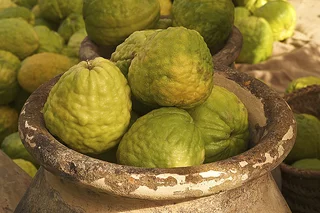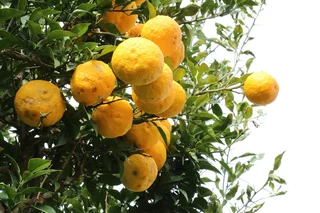Corsican citron or Citrus Medica

Corsican citron or Citrus Medica
A typical citrus fruit that grows mainly in Cap Corse, the Corsican citron is highly prized on the island of beauty. In liqueur, jam or as an ingredient in pastries, don't miss out on the special flavor of this citrus fruit, which is eaten from September to November!
Corsican citron, from jam to liqueur
Widely cultivated since the end of the 19th century, the Corsican citron is still harvested exclusively on the beautiful terraces of Cap Corse. Here, the citron is protected from the wind by tall hedges. The harvest - around 45,000 tonnes a year, the largest in the world - is mainly destined for export, regularly supplying the food industry in Italy and Northern Europe.
As historian Laurence Pinelli states: "The citron was a considerable source of wealth for Corsica. Its cultivation shaped the landscape, added much to our culinary heritage and considerably boosted the island's economy." It is also said to be one of the first citrus fruits to reach Corsican soil.
Corsican locals have also turned citron into a local specialty known as Cedratine. A liqueur once produced by monks and made from alcohol extracts, sugar, citron and natural plants. Today, citron is also used to make jam.

How to recognize the Corsican citron?
It's fairly easy to recognize the Corsican citron tree. First of all, there's the tree: slow-growing, it reaches a height of around 3 to 4 meters, open and spreading, rather small depending on the variety. Half thorny with large, robust thorns, its incredibly fragrant flower appears in March-April and lasts until September, producing excellent honey for bees.
The Corsican citron can also be recognized by its large, oblong leaves. When ripe, the fruit is yellow in color and up to 25 cm long. The thick, fleshy, wrinkled rind is used mainly in pastries, while the essence is used in perfumery. The citron is also called "Buddha's hand" because the fruit is shaped like fingers... While the flesh is sweet with a bitter aftertaste, the Corsican citron has almost no juice and offers a mild, acid-free flavor.
With its modest size, the Corsican citron is particularly well suited to pot cultivation.
What are these big lemons called? Properties of the yellow fruit.
It may look like a large lemon, but that's all! Its taste is less pronounced, its bumpy skin is bitter and its rare pulp rather acidic. Often used in essential oils, it helps to ward off colds and bronchitis in winter, and its high vitamin A, B and C content and beta-carotene content restore vitality when fatigue strikes. It is very popular for a variety of culinary and medicinal uses.
As part of its agroecological transition, Green Mission PF is working with citron suppliers in Corsica on a research program to use this fruit to combat ants.
Where does the citron grow?
Citron, known by its Latin name Citrus medica, is a citrus fruit in the Rutaceae family. The fruit is characterized by its lack of acidity, and can grow to several centimetres in length. In Europe, the citron thrives in mild climates, especially in southern valleys. Italy, Greece and Spain offer ideal conditions for its growth and annual production.
Cuisine: How do you eat a citron?
You'll often find them as candied fruit or in jam, but if you can find them fresh, we'll share our recipe with you.
A typical Corsican cake, this dessert is made with brocciu, a fromage frais made from sheep's milk.
Preparation time: 20 min. Cooking time: 30 min.
Ingredients
- 500 gr brocciu
- 100 g sugar
- 5 eggs
- ½ Corsican citron
- 2 tablespoons myrtle liqueur or classic brandy
Preparation Preheat the oven to 180°C to get a head start. Prepare the brocciu: place in a bowl and mash with a fork. If it looks too thick and there are still large chunks, you can blend it in a blender. Next, prepare the lemon: remove the citron zest using a peeler or zester. Once the zests have been removed, chop them finely or put them through a chopper for a finer result. Mix with the crushed brocciu. In a bowl, mix the eggs with the sugar and a little lemon juice, and the two spoonfuls of myrtle liqueur. Whisk with a fork until frothy. Add the brocciu with lemon zest and mix until smooth and homogeneous. Place the mixture in a buttered dish. Place the fiadone in the oven for around 25-30 minutes. The cake should be golden brown on top, then remove from the oven and leave to cool.

Before using the fruit, we advise you to remove the bitterness while preserving its aroma and fragrance. Simply immerse the peel in cold water for 5 days, changing the water every day.
Our local experts tell you all about our trips to Corsica!
Where can I find candied citron?
To find candied citron, especially in small pieces, you have several options:
Delicatessens and specialty stores: These stores often carry a selection of regional and artisanal products, which may include candied citron. Look for delicatessens that feature Corsican products for a better chance of finding quality candied citron.
Local markets in Corsica : Local markets are an excellent place to find fresh, artisanal products. During citron season, some local producers may offer candied citron, made in the traditional way.
Online stores specializing in Corsican products: Many Corsican producers and artisans sell their products online. This is a practical option if you're not in Corsica but want to buy authentic candied citron.
Make your own candied citron : If you have access to fresh citron, consider candying it yourself. The recipe involves cutting the citron into small pieces and candying them in a sugar syrup, which can be a rewarding culinary experience.
When buying candied citron, check the origin and method of manufacture to ensure the quality and authenticity of the product.
When is citron season?
The citron season in Corsica, marked by the blossoming of the citron flowers, begins in spring. However, the fruits themselves reach optimum ripeness between autumn and winter, mainly from October to February. During this period, the citron trees, adorned with their characteristic citron blossoms in spring, begin to bear their unique fruits, which gradually ripen to be harvested at the end of the year.




